Chris and Toby Marchant's home is a little like something out of a fairy tale. In the middle of the arable flatlands of Oxfordshire the timber-framed house is surrounded by a one-acre garden that weaves and unfolds in surprising ways. At various times Chris and Toby were able to purchase nearby fields, and to these they have added an orchard and nuttery, a native woodland and a larger field with pollarded willows and a wildflower meadows. The wider view is of a simple pastoral landscape of yesteryear.
IN BRIEF
What Contemporary garden with an emphasis on natural-style planting.
Where Oxfordshire.
Soil Alluvial silt with green sand pockets in low spots and subjected to prolonged winter flooding.
Size One acre, surrounded by orchard, nuttery, woodland and wildlife refuge.
Climate The house sits in an open frost pocket where winter temperatures quite regularly drop to -10oC.
Hardiness zone USDA 8.
Chris and Toby know a thing or two about plants, for more than 30 years they ran Orchard Dene Nurseries, and as growers they were famed for their flawless production values. Their plants could be found growing in countless award-winning RHS Chelsea Flower Show gardens and the nursery was loved by every garden designer you can think of. Knowing how impeccably the nursery was run, I was a little taken aback at how effortlessly laid back the garden is, gently tamed within its wild exteriors. “We actually just want to enjoy it all and garden,” says Chris. “What we love is the process of gardening, rather than the end product. We don’t actually want it to be finished.”
Such graceful planting is a result of decades of knowledge and deep understanding of how plant communities interact. The garden is made up of a series of matrices. “We use a predominance of two or three things that are reliable and then punctuate these with other plants that either emerge or contrast,” says Chris. These matrices are designed to cover the ground naturally and keep the soil in good health, reducing the need for unnecessary intervention and to keep down weeding.
From an understorey of low sedges and ornamental grasses, including Carex digitata, Carex morrowii ‘Irish Green’, Melica altissima ‘Alba’ and Sesleria autumnalis, rise taller plants, such as amsonias, actaeas, kalimeris and thalictrums. Essentially, plants are allowed to co-exist naturally, but as Chris explains nothing is left in one place for ever, everything is allowed to move. “Sometimes we have to edit because some things are self-seeding a little too much,” she says.
The central garden is the sunniest part and has a large round lawn, although Chris admits that it’s more a tapestry of green species and they use varying mowing regimes to create longer-grassed areas.
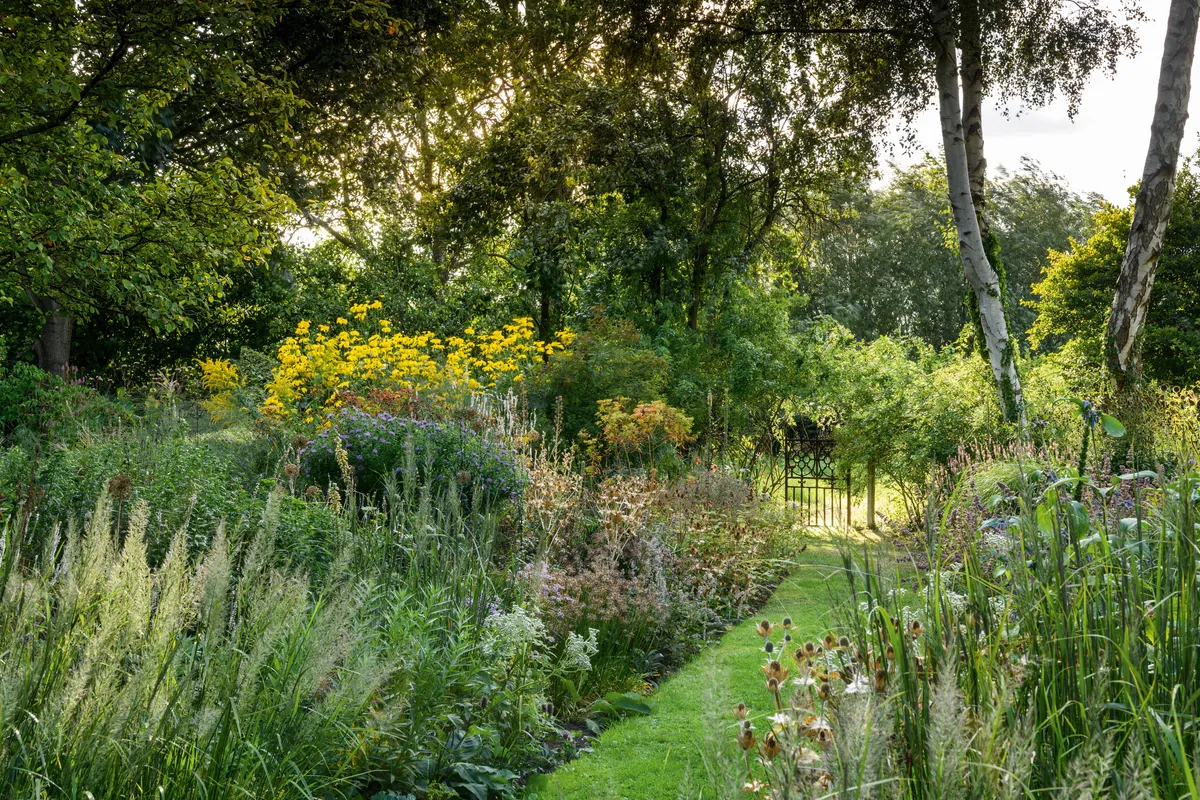
Around this sit two wide borders dedicated to decorative herbaceous planting with a central grass path that snakes away to the wilder reaches. “These borders are the mainstay of the late-summer garden with a wider range of colours, often seen through a veil of grasses,” says Chris. Plants include Veronicastrum virginicum ‘Album’, Vernonia arkansana, Eupatorium maculatum ‘Riesenschirm’, Clematis ‘Mrs Robert Brydon’ and Strobilanthes atropururea.
By autumn the garden begins to mellow into a golden haze of coppers and oranges, punctuated here and there with violet hues. There’s a smattering of annuals and biennials, such as Patrinia monandra, Orlaya grandiflora, Digitalis ferruginea and Delphinium requienii, used for seasonal variance. “These are useful for filling gaps in early year plantings or when the borders are reorganised,” explains Toby.
The result is a garden that is as peaceful as it is playful, that embraces its wild edges and inhabitants to create a space of ecological wealth with some spectacular plant selections. Just as you might expect from two of horticulture’s finest plantspeople.
Highlights from around the garden
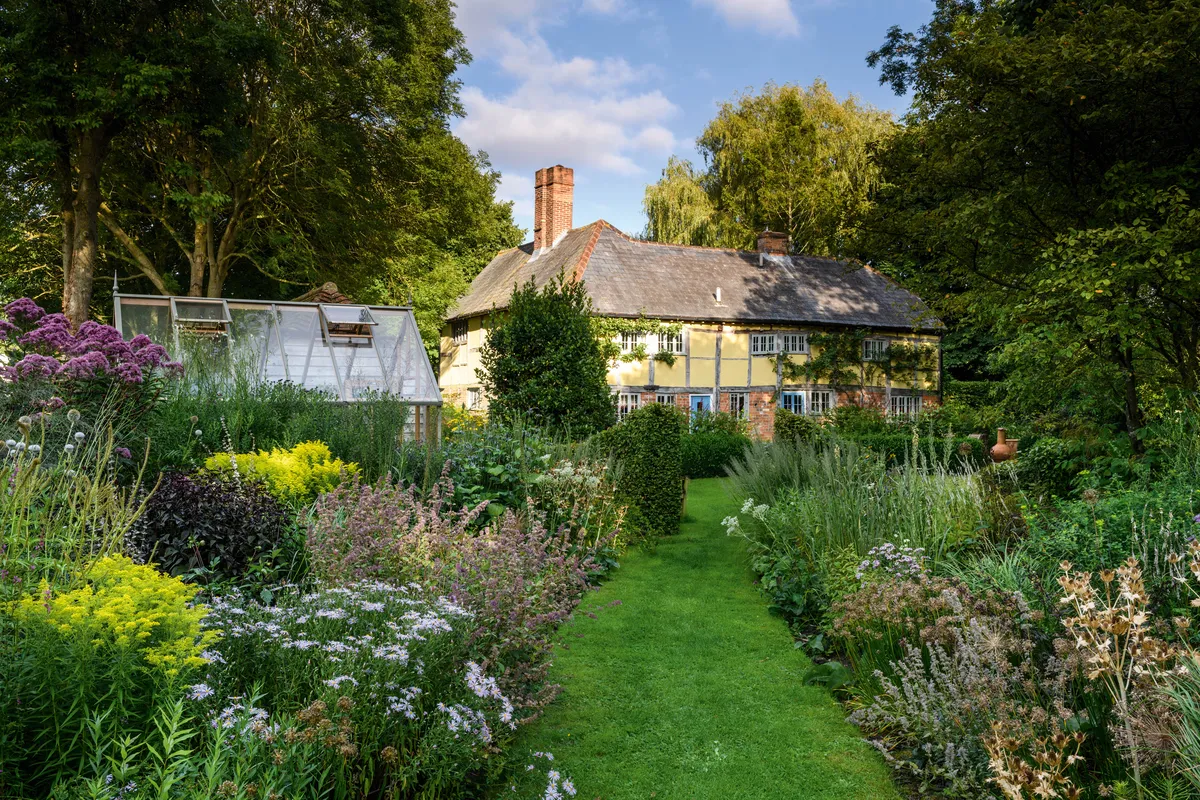
Two large herbaceous borders are the mainstay of the late-summer garden when the likes of Eupatorium maculatum 'Riesenchirm', Eryngium 'Silver Ghost' and an unnamed Solidago from Piet Oudolf's garden, Hummelo.
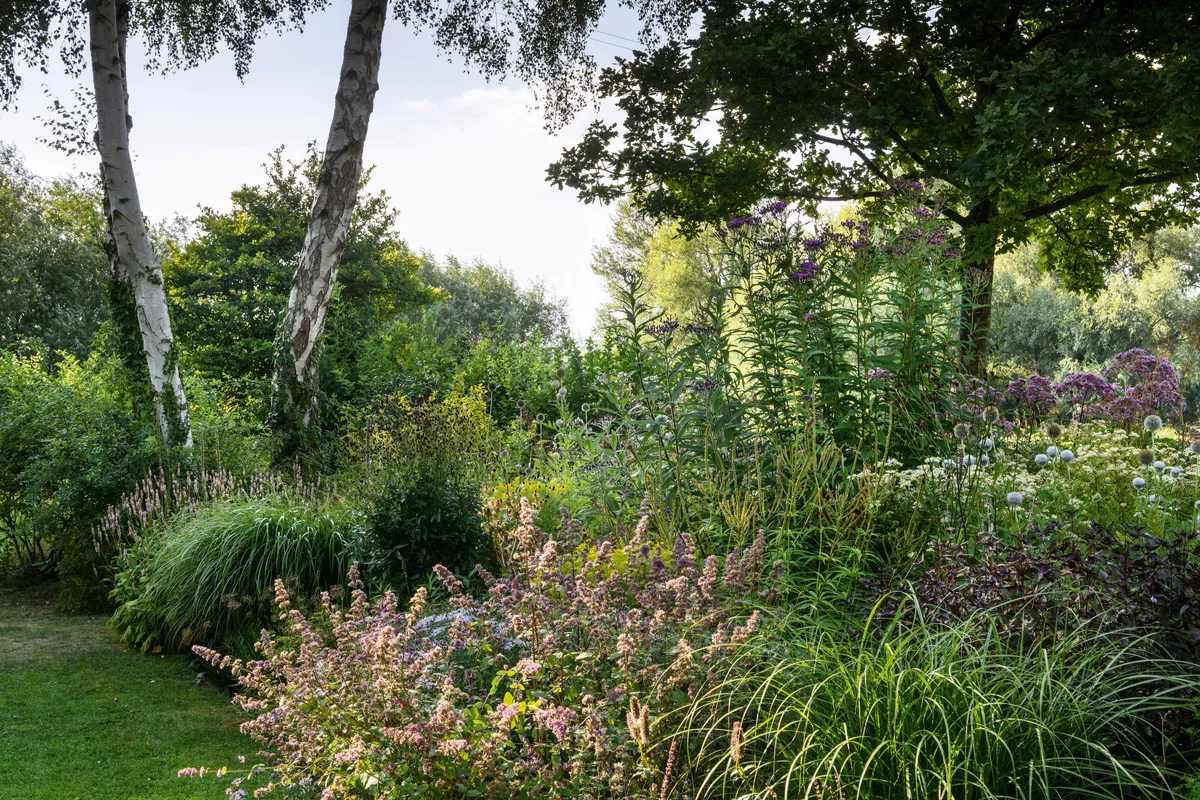
Many tall plants, including eupatoriums, echinops, veronicastrums and sanguisorbas, emerge from a tapestry of foliage, yet there’s very little apparent staking. “ We prefer to install hazel supports early in spring to create a natural corsetry to plants that might need it,” explains Chris. “This allows for important movement later in the season as taller, agile plants ascend above the twigs and are allowed to flex in the breeze.”

A central grass path, leading to the wilder parts of the garden, divides the two wide borders separating drifts of the feathery grass Calamagrostis brachytricha, the purple aster Symphyotrichum novae- angliae ‘October Skies’ and tall, yellow Rudbeckia laciniata ‘Herbstsonne’ from the buff seedheads of Eryngium giganteum ‘Silver Ghost’.
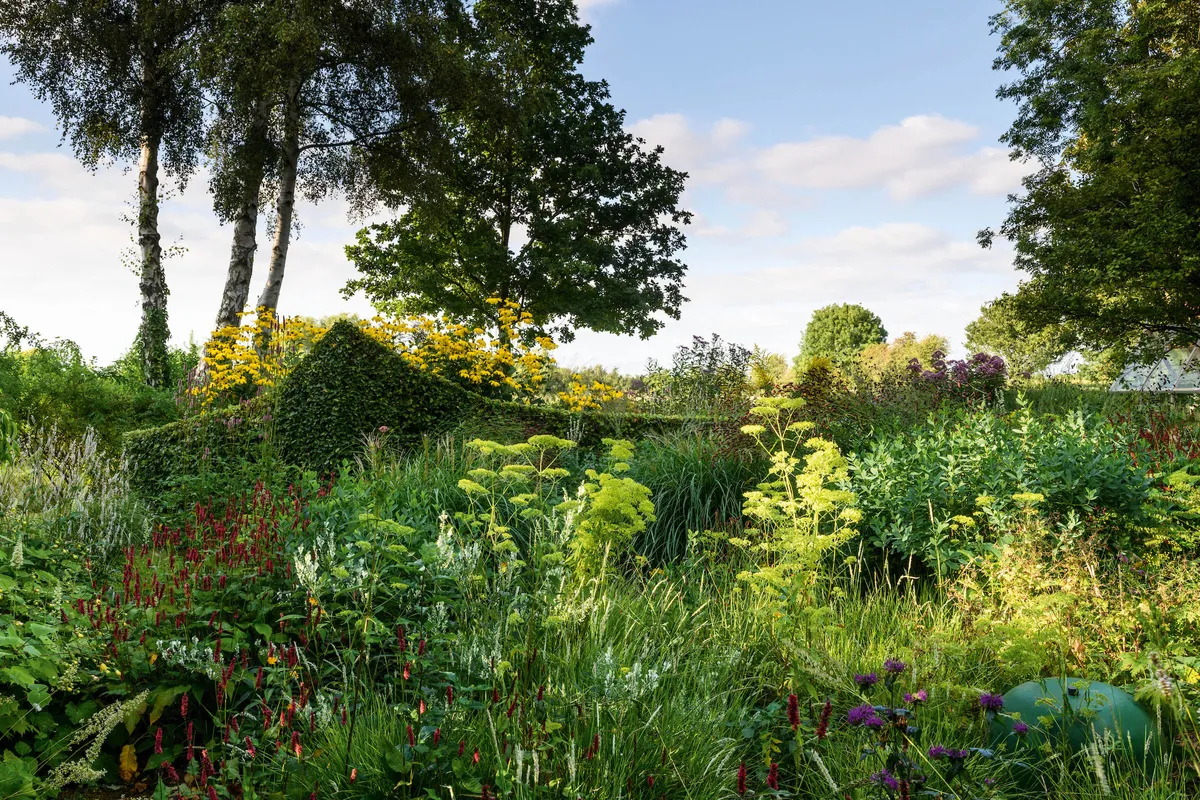
Neither Chris nor Toby were very keen to use too much hard landscaping in the garden. Instead structure comes from paths and sculpturally cut hedges – mainly box and undulating hornbeam – which gives shape and framing for the looser planting. “We’ll mow a crisp strip alongside an edge rather like framing a picture,” says Chris. “It adds an immediate definition and holds the loose internal planting. Sometimes that’s all that’s needed to lift a space.’’
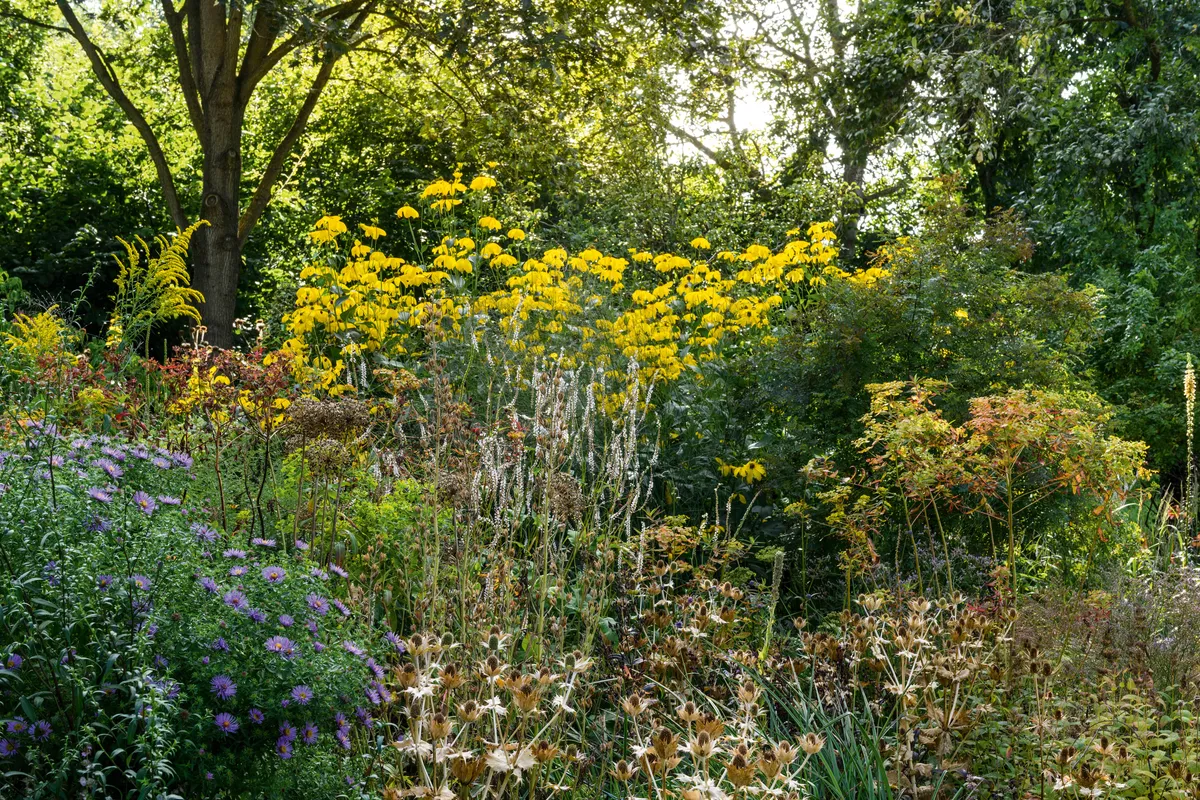
The tall Rudbeckia laciniata ‘Herbstsonne’ rises out of a mixed planting of Solidago rugosa ‘Fireworks’, Symphyotrichum oblongifolium ‘October Skies’, the fading seedheads of Eryngium giganteum ‘Silver Ghost’ and various alliums. “The rudbeckia grows to at least three metres and is so tall you can see it even when lying in the bath,” says Chris. “It’s like a ray of sunshine in the late summer garden.”
Don't miss Chris Marchant's advice on the best ground cover plants for sun and shade.
